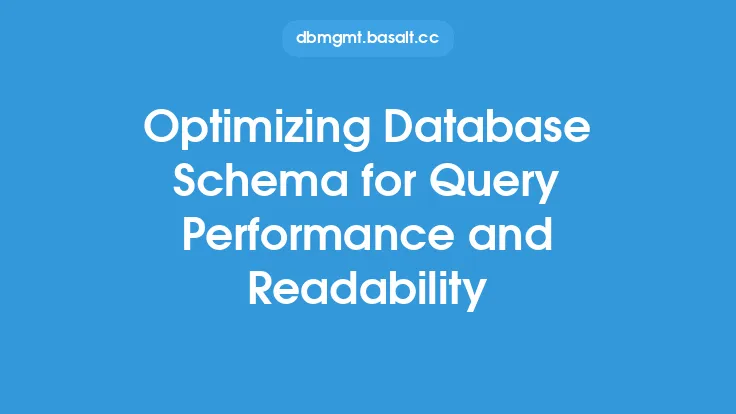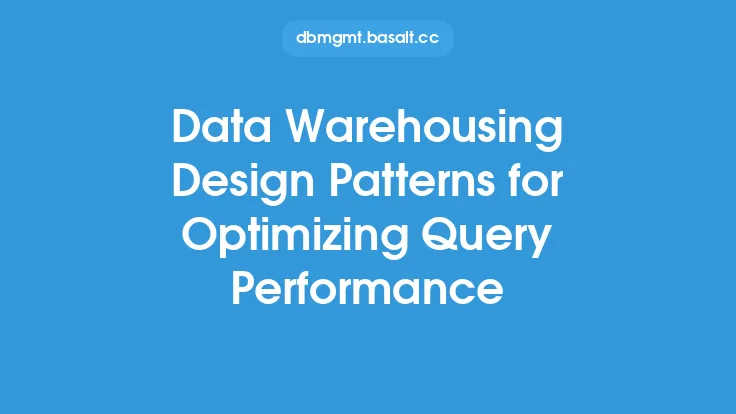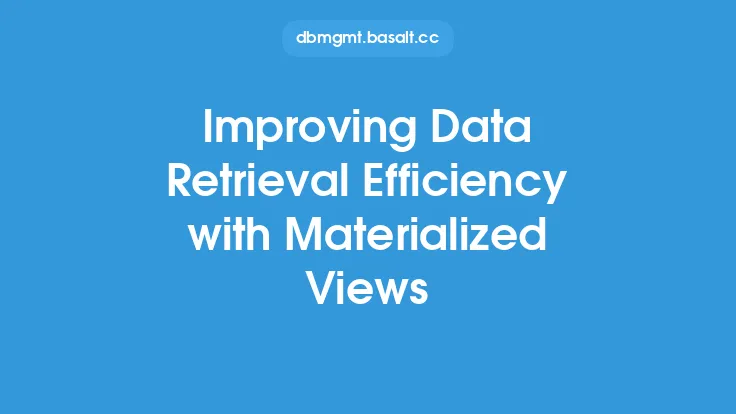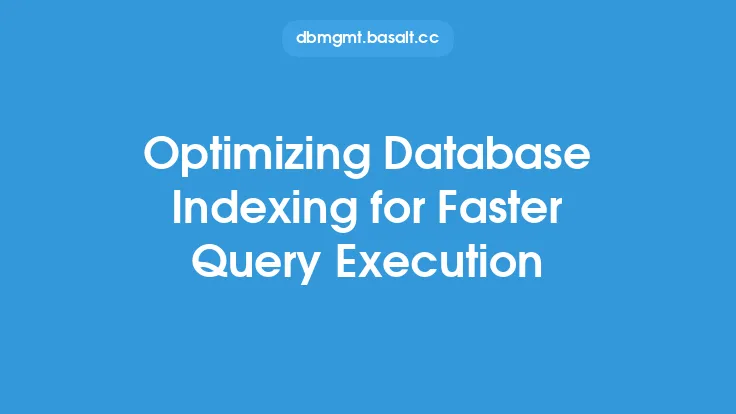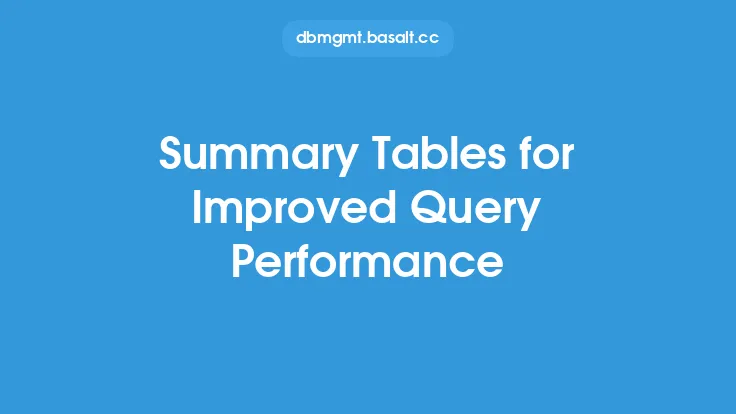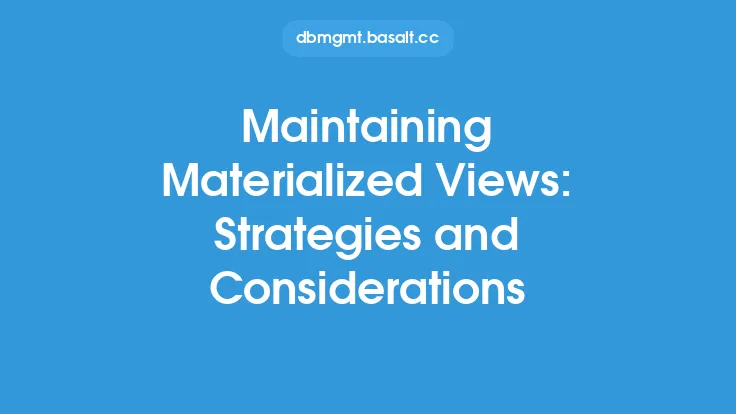Optimizing query performance is a crucial aspect of database management, as it directly impacts the efficiency and responsiveness of applications. One effective technique for achieving this optimization is through the use of materialized views. A materialized view is a database object that stores the result of a query in a physical table, allowing for faster access to the data. In this article, we will delve into the details of how materialized views can be used to optimize query performance, and explore the various techniques and strategies for implementing them effectively.
Introduction to Materialized Views
Materialized views are essentially pre-computed results of a query, stored in a physical table. This allows the database to retrieve the results directly from the materialized view, rather than having to execute the query every time it is requested. Materialized views can be used to improve query performance in a variety of scenarios, including complex queries, aggregate queries, and queries that involve large amounts of data. By storing the results of a query in a materialized view, the database can reduce the amount of processing required to execute the query, resulting in faster response times and improved overall performance.
How Materialized Views Optimize Query Performance
Materialized views optimize query performance in several ways. Firstly, they reduce the amount of processing required to execute a query, as the results are pre-computed and stored in a physical table. This means that the database does not have to execute the query every time it is requested, resulting in faster response times. Secondly, materialized views can reduce the amount of data that needs to be retrieved from the underlying tables, as the materialized view only stores the data that is required for the query. This can result in significant performance improvements, especially for queries that involve large amounts of data. Finally, materialized views can improve query performance by allowing the database to use more efficient query execution plans, as the materialized view can be used as a source of data for the query.
Types of Materialized Views
There are several types of materialized views, each with its own strengths and weaknesses. The most common types of materialized views are:
- Simple materialized views: These are the most basic type of materialized view, and store the result of a single query.
- Aggregate materialized views: These store the result of an aggregate query, such as a SUM or COUNT.
- Join materialized views: These store the result of a query that involves joining multiple tables.
- Complex materialized views: These store the result of a complex query, such as a query that involves subqueries or window functions.
Each type of materialized view has its own use cases, and the choice of which type to use will depend on the specific requirements of the application.
Creating and Maintaining Materialized Views
Creating and maintaining materialized views requires careful planning and consideration. When creating a materialized view, the database administrator must specify the query that will be used to populate the materialized view, as well as the frequency at which the materialized view will be updated. The frequency of updates will depend on the requirements of the application, as well as the amount of data that is being stored in the materialized view. In general, materialized views should be updated regularly to ensure that the data remains consistent with the underlying tables. This can be achieved through the use of refresh mechanisms, such as periodic refresh or incremental refresh.
Query Optimization Techniques
There are several query optimization techniques that can be used in conjunction with materialized views to further improve query performance. These include:
- Indexing: Creating indexes on the columns used in the materialized view can improve query performance by allowing the database to quickly locate the required data.
- Partitioning: Partitioning the materialized view can improve query performance by allowing the database to quickly eliminate partitions that do not contain the required data.
- Caching: Caching the results of frequently executed queries can improve query performance by reducing the amount of processing required to execute the query.
- Rewriting queries: Rewriting queries to use the materialized view can improve query performance by allowing the database to use more efficient query execution plans.
Best Practices for Implementing Materialized Views
When implementing materialized views, there are several best practices that should be followed. These include:
- Carefully evaluate the query: Before creating a materialized view, carefully evaluate the query to ensure that it is optimized for performance.
- Choose the correct type of materialized view: Choose the correct type of materialized view based on the requirements of the application.
- Regularly update the materialized view: Regularly update the materialized view to ensure that the data remains consistent with the underlying tables.
- Monitor performance: Monitor the performance of the materialized view to ensure that it is providing the expected benefits.
Common Challenges and Limitations
While materialized views can be a powerful tool for optimizing query performance, there are several common challenges and limitations that should be considered. These include:
- Data consistency: Ensuring that the data in the materialized view remains consistent with the underlying tables can be a challenge.
- Storage requirements: Materialized views can require significant storage space, especially for large datasets.
- Maintenance overhead: Maintaining materialized views can require significant overhead, especially for complex materialized views.
- Query complexity: Materialized views can be limited in their ability to handle complex queries, such as queries that involve subqueries or window functions.
Conclusion
In conclusion, materialized views are a powerful tool for optimizing query performance in databases. By storing the results of a query in a physical table, materialized views can reduce the amount of processing required to execute the query, resulting in faster response times and improved overall performance. However, implementing materialized views requires careful planning and consideration, and there are several common challenges and limitations that should be considered. By following best practices and using query optimization techniques, database administrators can effectively use materialized views to improve query performance and provide faster, more responsive applications.
